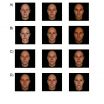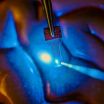(Press-News.org) A longstanding question among scientists is whether evolution is predictable. A team of researchers from UC Santa Barbara may have found a preliminary answer. The genetic underpinnings of complex traits in cephalopods may in fact be predictable because they evolved in the same way in two distinct species of squid.
Last, year, UCSB professor Todd Oakley and then-Ph.D. student Sabrina Pankey profiled bioluminescent organs in two species of squid and found that while they evolved separately, they did so in a remarkably similar manner. Their findings are published today in the Proceedings of the National Academy of Science.
Oakley, professor and vice chair of UCSB's Department of Ecology, Evolution and Marine Biology, and Pankey, now a postdoctoral scholar at the University of New Hampshire, leveraged advances in sequencing technology and cutting-edge genomic tools to test predictability in the evolution of biological light production.
They chose to work with the Hawaiian bobtail squid (Euprymna scolopes) and the swordtip squid (Uroteuthis edulis), a Japanese species used for sushi. These distantly related species are two of five genera known to have bioluminescent organs called photophores. The photophores contain symbiotic, light-emitting bacteria, and the squid are capable of controlling the aperture of their organ to modulate how much light is produced.
The scientists wanted to know how similar the two species' photophores are in terms of their genetic makeup. To find the answer, they sequenced all of the genes expressed in these light organs, something that could not be done using older sequencing technology.
"They are much more similar than we expected in terms of their genetic makeup," Oakley said. "Usually when two complicated organs evolve separately we would expect them to take very different evolutionary paths to arrive where they are today. The unexpectedly similar genetic makeup demonstrates that these two squid species took very similar paths to evolve these traits."
More specifically, the researchers demonstrated that bioluminescent organs originated repeatedly during squid evolution and then showed that the global gene expression profiles (transcriptomes) underlying those organs are strikingly — even predictably — similar. To confirm their hypothesis and findings, Oakley and Pankey enlisted the assistance of statisticians from the University of Washington and UCLA, who developed new statistical methods to test the idea of convergent (separately evolved) origins.
"I did find some individual genes that were counter to the main pattern, which means we can no longer study just one gene anymore in order to test these questions about the genetic basis of convergence," said Pankey. "We're at the point now where we need to — and can — study all of them."
Some previous experiments have indicated that these squid use their bioluminescent capabilities for camouflage, as counterintuitive as that may seem. "If you imagine lying on your back in the deep ocean and looking up, almost all the light comes from straight above," Oakley explained. "There's no structure like walls or trees to reflect the light, so if there's something above you, it's going to cast a shadow. The squid can produce light that then matches the light from behind them so it blocks their shadow to a viewer below, which is a type of camouflage."
The team's results demonstrate that the evolution of overall gene expression underlying convergent complex traits may be predictable. This finding is unexpected and could indicate unusually strong constraints: The probability of complex organs evolving multiple times with similar trajectories should be vanishingly small, noted Oakley. Yet the team's novel bioinformatic approaches indicate the evolution of convergent phenotypes is associated with the convergent expression of thousands of genes.
"These results have broad implications for workers in the fields of evolution, genetics, genomics/bioinformatics, biomaterials, symbiosis, invertebrate zoology and evolutionary development," Oakley concluded.
INFORMATION:
Research in recent years has shown that people associate specific facial traits with an individual's personality. For instance, people consistently rate faces that appear more feminine or that naturally appear happy as looking more trustworthy. In addition to trustworthiness, people also consistently associate competence, dominance, and friendliness with specific facial traits. According to an article published by Cell Press on October 21st in Trends in Cognitive Sciences, people rely on these subtle and arbitrary facial traits to make important decisions, from voting for ...
(SALT LAKE CITY)—Workers punching in for the graveyard shift may be better off not eating high-iron foods at night so they don't disrupt the circadian clock in their livers.
Disrupted circadian clocks, researchers believe, are the reason that shift workers experience higher incidences of type 2 diabetes, obesity and cancer. The body's primary circadian clock, which regulates sleep and eating, is in the brain. But other body tissues also have circadian clocks, including the liver, which regulates blood glucose levels.
In a new study in Diabetes online, University ...
DURHAM, N.H. –- Crewed missions to Mars remain an essential goal for NASA, but scientists are only now beginning to understand and characterize the radiation hazards that could make such ventures risky, concludes a new paper by University of New Hampshire scientists.
In a paper published online in the journal Space Weather, associate professor Nathan Schwadron of the UNH Institute for the Study of Earth, Oceans, and Space (EOS) and the department of physics says that due to a highly abnormal and extended lack of solar activity, the solar wind is exhibiting extremely ...
DURHAM, N.H. – Six percent of U.S. children and youth missed a day of school over the course of a year because they were the victim of violence or abuse at school. This was a major finding of a study on school safety by University of New Hampshire researchers published this month in the Journal of School Violence.
"This study really highlights the way school violence can interfere with learning," says lead author David Finkelhor, professor of sociology and director of the Crimes Against Children Research Center (CCRC) at UNH. "Too many kids are missing school ...
New research shows that a preservation technique known as sequential subnormothermic ex vivo liver perfusion (SNEVLP) prevents ischemic type biliary stricture following liver transplantation using grafts from donations after cardiac death (DCD). Findings published in Liver Transplantation, a journal of the American Association for the Study of Liver Diseases and the International Liver Transplantation Society, indicate that the preservation of DCD grafts using SNEVLP versus cold storage reduces bile duct and endothelial cell injury post transplantation.
The shortage ...
VIDEO:
Scientists at the US Department of Energy's Ames Laboratory modeled the 'passing probability' of molecules within the narrow pores of mesoporous nanoparticles. This understanding will help determine the optimal diameter...
Click here for more information.
Scientists at the U.S. Department of Energy's Ames Laboratory have developed deeper understanding of the ideal design for mesoporous nanoparticles used in catalytic reactions, such as hydrocarbon conversion to biofuels. ...
ATLANTA—Animal-assisted therapy can reduce symptoms of anxiety and loneliness among college students, according to researchers at Georgia State University, Idaho State University and Savannah College of Art and Design. Their findings are published in the latest issue of the Journal of Creativity in Mental Health.
The researchers provided animal-assisted therapy to 55 students in a group setting at a small arts college in the Southeast. They found a 60 percent decrease in self-reported anxiety and loneliness symptoms following animal-assisted therapy, in which a ...
MADISON, Wis. — Developing invisible implantable medical sensor arrays, a team of University of Wisconsin-Madison engineers has overcome a major technological hurdle in researchers' efforts to understand the brain.
The team described its technology, which has applications in fields ranging from neuroscience to cardiac care and even contact lenses, in the Oct. 20 issue of the online journal Nature Communications.
Neural researchers study, monitor or stimulate the brain using imaging techniques in conjunction with implantable sensors that allow them to continuously ...
WASHINGTON D.C. Oct. 21, 2014 -- The most obvious effects of too much sun exposure are cosmetic, like wrinkled and rough skin. Some damage, however, goes deeper—ultraviolet light can damage DNA and cause proteins in the body to break down into smaller, sometimes harmful pieces that may also damage DNA, increasing the risk of skin cancer and cataracts. Understanding the specific pathways by which this degradation occurs is an important step in developing protective mechanisms against it.
Researchers from the École Polytechnique Fédérale de Lausanne ...
By analysing DNA extracted from the petrous bones of skulls of ancient Europeans, scientists have identified that these peoples remained intolerant to lactose (natural sugar in the milk of mammals) for 5,000 years after they adopted agricultural practices and 4,000 years after the onset of cheese-making among Central European Neolithic farmers.
The findings published online in the scientific journal Nature Communications (21 Oct) also suggest that major technological transitions in Central Europe between the Neolithic, Bronze Age and Iron Age were also associated with ...








